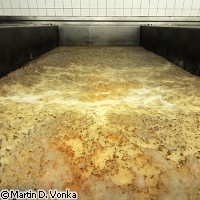Selfish gene drives social cooperation in yeast
EU-funded scientists have identified a single gene that drives social behaviour in yeast. Yeast cells that have the gene FLO1 will literally stick together to protect each other from threats such as antibiotics or alcohol. Meanwhile, yeast cells lacking the FLO1 gene are excluded from the group. As well as shedding new light on the evolution of social behaviour and the workings of selfish genes, the findings could prove useful in the brewing industry and in hospitals, where many disease-causing types of yeast also clump together, making them extremely difficult to treat. The work, which is published in the journal Cell, was partly supported through the EU-funded FUNGWALL ('The fungal cell wall as a target for antifungal therapies') project, which is financed through the 'Life sciences, genomics and biotechnology for health' Thematic area of the Sixth Framework Programme (FP6). The ability of yeast (Saccharomyces cerevisiae) to form clumps is well known to brewers, who exploit this capability in order to remove the yeast from the beer once fermentation is complete. However, this trait has been largely ignored by scientists, and many of the strains of yeast used in laboratories have had this clumping tendency bred out of them. In this latest study, scientists from Belgium, France and the US explain how a single gene, FLO1, is responsible for yeast's clumping behaviour. FLO1 produces an adhesive protein on the cell surfaces that causes individual yeast cells to stick together and form vast clumps (also known as 'flocs') containing thousands of cells. Cells on the inside of the clump are shielded from stress, antibiotics and other dangers by the cells on the outside, which sacrifice themselves for the common good. One would expect such a system to favour 'cheaters', cells that do not invest in producing the sticky protein yet benefit from the protective nature of the clumping behaviour. Such cheaters would in theory fare better than non-cheaters and eventually come to dominate the population. In fact this rarely happens. Cooperation often brings benefits to both the helper and the helped. Individuals may also be inspired to help relatives, as this will also help to ensure that their genes (which their relatives also carry) are passed on to the next generation. However, in the case of the yeast, FLO1 gets around the problem of cheaters another way. 'Remarkably, cells expressing FLO1 are not only working together against stress, they are also able to exclude cells that do not express FLO1 from the floc, leaving these hopeful cheaters unprotected,' explains Kevin Verstrepen of Harvard University in the US and the Flanders Institute for Biotechnology (VIB) in Belgium. 'One gene does it all.' The researchers suggest that the mechanism involved could be quite simple: two cells with FLO1 proteins can form two-way attachments that are stronger than the one-way interactions between a cell with the sticky proteins and a cell lacking them. The effect of FLO1 is so strong that yeast cells of different species will happily stick together as long as they both have the FLO1 gene. This leads the researchers to speculate that FLO1 may be a 'green beard gene'. These are genes that both drive cooperation and ensure that altruistic individuals can be identified, so that cheaters can be excluded and prevented from taking over the population. So far, very few green beard genes have been found. 'FLO1 also provides striking support for the 'selfish gene theory', which puts genes, and not genomes, at the centre of evolution,' comments Harvard University's Kevin Foster. 'FLO1 is a selfish gene that promotes its own proliferation without much influence from the rest of the genes in the genome - although remarkably, it exercises this 'selfish' act by promoting an act of social cooperation.' The work could have important practical implications. The researchers found that yeast only produce the sticky FLO1 protein when the presence of another chemical tells them that there are lots of other yeast cells in their vicinity; brewers could exploit this information to control the clumping behaviour of their yeast for optimal beer production. In clinical settings, disease-causing yeast cells often clump into biofilms that are extremely difficult to treat. In people whose immune systems are weakened as a result of cancer treatments, HIV infection or organ transplants, these infections can be deadly. 'Thousands of people die every year not from AIDS or cancer, but from yeast infections,' says Dr Verstrepen. 'Once in the bloodstream, it's a very deadly disease.' Knowing what causes yeast to clump together could help doctors to combat these infections, the researchers hope.
Countries
Belgium, France, United States



